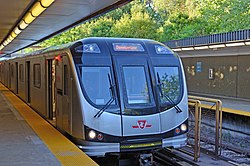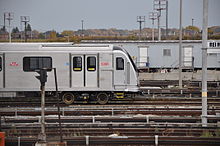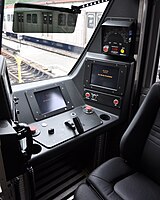Toronto Rocket
| Toronto Rocket | |
|---|---|
 Toronto Rocket subway train at Rosedale Station | |
| In service | 2011–present |
| Manufacturer | Bombardier Transportation |
| Built at | Thunder Bay, Ontario |
| Family name | Movia |
| Replaced | H4, H5, H6 |
| Constructed | 2008–present |
| Number under construction | 79 six-car trains on order[1][2][3] |
| Number built | 62 trains (5381-5996) |
| Number in service | 62 trains as of April 2015[4] |
| Formation | 6-car permanently coupled sets |
| Fleet numbers | 5381-6176[5] (re-used from retired TTC vehicles, H1, H2, H4, H5, H6 subway trains, and Flyer D-901A buses, car numbers ending with 7, 8, 9 or 0 are not used) |
| Capacity | 60-68 (seated/per car)[1] 1100 (full train, crush load)[6] |
| Operators | Toronto Transit Commission |
| Depots | Wilson Subway Yard Davisville Subway Yard |
| Lines served | |
| Specifications | |
| Car body construction | stainless steel[7] |
| Car length | 23.190 m (76.08 ft) [5] |
| Height | 3.137 m (10.29 ft)[5] |
| Doors | 8 sets (4 sets per side) per car |
| Maximum speed | 88 km/h (55 mph)[5] |
| Weight | 205,000 kg (202 long tons; 226 short tons) (per trainset); 34,167 kg (33.627 long tons; 37.663 short tons) per car[5] |
| Traction system | Bombardier MITRAC three phase AC traction motors |
| Acceleration | 0.90 m/s2 (3.0 ft/s2) (limited) |
| Deceleration | 1.35 m/s2 (4.4 ft/s2), 1.5 m/s2 (4.9 ft/s2) (Emergency) |
| Auxiliaries | 120/208 VAC Battery Auxiliary |
| Electric system(s) | 600 V DC (third rail) |
| Current collector(s) | Contact shoe |
| Braking system(s) | Regenerative and Pneumatic |
| Safety system(s) | Emergency evacuation ramps at each end of trainset |
| Track gauge | 4 ft 10+7⁄8 in (1,495 mm) Toronto gauge |
The Toronto Rocket (TR) is the newest version of subway trains on the Toronto Transit Commission's (TTC) subway/RT network in Toronto, Ontario, Canada. The trains are built by Bombardier Transportation in Thunder Bay, with designs based on Bombardier's Movia family of trains.
The TRs are the only trains in the TTC subway train rolling stock that feature full-width interior gangways allowing passengers to walk through the length of the train. In other models, it is prohibited (in accordance with TTC By-law #1) to walk between the cars via the inter-car doors.
They are arranged in a six-car fixed configuration with two cab cars (allocated at the first and last cars of the train) and four non-driving cars, while other TTC train models are built in two-car mated pairs which operate in sets of two or three, forming four- or six-car trains.
The TR series trains operate on Line 1, (Yonge–University subway). They have replaced the remaining H5 and nearly all T1 series subway trains that used to be operated on the line (although Yonge–University is still supplemented sometimes by the T1 trains). The T1 series trains now operate mostly on Line 2 Bloor–Danforth and Line 4 Sheppard, where they replaced the remaining H4 and H6 series trains.
Name
The trains were designated under the production name as T35A08 before the name "Toronto Rocket" was chosen through a contest open to the public.[8][9]
Delivery
Deliveries of the new TR trains was expected to begin in late 2009, and they were scheduled to enter passenger service in early 2010. However, delivery was delayed by the bankruptcy of a key part manufacturer, Curtis Doors, which was to install door components for the TTC's new subway trains.[5][6][10]
The initial order was signed in 2006 for the delivery of 234 cars, making 39 six-car fixed trains which allowed for the retirement of the H4 and H5 subway cars.
On May 6, 2010, the TTC voted to exercise a contract option with Bombardier for an additional 186 cars, making 31 six-car fixed train sets. This allowed for the retirement of the older H6 series trains, and to have enough TR trains to meet future ridership demands for the opening of the Spadina Subway extension to the Vaughan Metropolitan Centre which was then scheduled for commissioning to being in early 2015.[2][11] (opening has since been delayed until December 2017).[12]
A further 10 train sets (60 cars) were authorized in March 2014 to bring the total to 80 six-car train sets and 480 cars.[3] In March 2015 the TTC reported that the T1 trains running on Line 4 Sheppard would have to be replaced with TR trains before conversion of Line 1 Yonge-University to automatic train control (ATC) in 2020, and that TTC would report soon on the option of converting an existing six-car train to a four-car train to test One Person Train Operation (OPTO).[13][dead link]
On October 1, 2010, the first train set (5391-5396) was delivered to Wilson Yard. It was unveiled to the public and media at Downsview station on October 14, 2010.[14]
The first set (5411-5416) entered revenue service on July 21, 2011. As of April 2015, 61 TR trains are available for revenue service.
Features
The new TR series trains have several new features that make them more accessible and user-friendly for passengers including:
- A "six-car-fixed" configuration with full open interior gangways, allowing riders to move freely from one end to the other.
- An exterior blue light on each car leading to the nearest accessible seating area for passengers using mobility devices.
- Red stanchions and high visibility floor markings for visually impaired passengers.
- Antimicrobial properties on various surfaces.
- Doubled number of accessible seats (covered in blue velour; other seats are covered in red velour like all other TTC vehicles have) in each car compared with the T1 series subway cars, with automatic flip-up seats, which mark priority seating areas (similar to those used on the new Flexity Outlook streetcars) to accommodate mobility devices such as walkers, wheelchairs, bicycles and strollers.
- Automated stop announcement system with audio (uses female computerized voice announcer) and visual displays with arrows that indicate which side doors will open on at the next stop. The stop announcements are played twice: the first announcement is played shortly after the train departs the station, (for instance: "Next station is Rosedale, Rosedale station") which is followed by a second announcement when the train arrives at the station, (for instance: "Arriving at Rosedale, Rosedale station"). Unlike other trains, the TRs also announce if the station is an interchange station: "This station connects with the Bloor-Danforth subway" and/or "This station connects with the Sheppard subway" respectively. If the station is a terminal station, "This is a terminal station" is also broadcast. Both messages precede the stop announcements and they are also posted on stop announcement displays respectively.
- Electronic lighted route maps that indicate which stations have been served and which stations are next to follow (green dots indicate the stations that have already been served, steady red dots indicate the stations that have yet to be served, flashing green dots indicate the station to be served next and interchange stations are lit in yellow dots).
- A two-way passenger assistance intercom system for passengers to communicate with the train crew in the event of an emergency.
- Built-in evacuation ramps located at the ends of the train to allow for faster and easier evacuation in the event of an emergency.
- Full-width operator cabs located at the ends of the train (similar to those on the TTC's new Flexity Outlook streetcars and Line 3 Scarborough trains) for the enhanced safety and security of operating personnel (as operators are allowed to access the cab unit directly from the subway platform and are not exposed to the public while performing operating duties). As such, there is no front or rear facing window accessible to passengers, since it has been sealed off with a one-way mirror.
- Bright orange digital LED exterior destination and train run number signs (which show three digits as opposed to two digits on previous models) displayed at the ends of the train.
- Ceiling-mounted CCTV cameras with four in each car for passenger safety and security (a feature already in place on TTC's surface vehicles including buses and streetcars). Footage is recorded and can be reviewed in the event of an incident.
- Video screens displaying safety messages, TTC-related advertising and the name of the next station at the bottom.
Retrofits
In February 2013, the TTC began a trial phase with the installation of external door chimes (on each set of doorway) and additional yellow plastic straps (placed underneath the HVAC units) on the TR trains. Set 5461-5466 was the first to be retrofitted, followed by set 5851-5856 in May 2014. The rest of the TR trains fleet has the door chimes played inside the train via the public address system. The retrofitted trains have a lower pitched three-tone warning chime (F♯,D♯,B). The last TR train delivered to the TTC (set 60, 5971-5976) entered service in February 2015, equipped with additional yellow plastic straps. The other TR trains have a higher pitched three-tone warning chime (G,E,C). The message "Please stand clear of the doors" overlaps the warning chime, while the message precedes the warning chime on the other TR trains. It has been reported that all TR trains will eventually be retrofitted with external door chimes along with yellow plastic straps by approximately late 2016.[15][7][16][17][18]
-
Gangway between cars. The poster, in French, when translated into English, reads "The Toronto Rocket is jointly financed by the Government of Canada, the Province of Ontario, and the City of Toronto."
-
Exterior view of the gangway
-
View along full length of train
-
Side view of cab car, seen at Wilson yard
-
Operator's cab
-
Accessible seating position
-
Front view at St. George station
Financing
The TR trains are jointly funded by all three levels of government, including the City of Toronto (via Toronto Transportation Services), the Province of Ontario (via the Ministry of Transportation) and the Government of Canada (via Transport Canada).
Interior design
The interior scheme on the TR trains are similar to the previous model, the T1 series. Unlike the older versions of subway cars, they have full-open interior gangways. The colour scheme consists of white cream walls, silver doorways, and grey floors with red floor markings for visually impaired passengers.
Fleet numbers
The TR train sets are numbered 5381-6176.[1] Each set is numbered 5xx1-5xx6; car numbers ending in 0, 7, 8 and 9 are not used. These will be the first trains to adopt numbering in the 6000s, since the TRs are a six-car fixed configuration (unlike previous models which are formed in married pairs). Sets are numbered, for example, 5381-5382-5383-5384-5385-5386 and so on. At one point, two train sets had their numbers temporarily exchanged. These included sets 5781-5786 in which the exterior bore the number 5803, while train set 5801-5806 bore 5783 on the exterior car. They have since been resolved as 5803 on 5781-5786 was renumbered as 5783, and train set 5801-5806 which bore 5783 was renumbered as 5803.
Criticism
Tendering process
During the tendering process, Siemens Canada (see Siemens Modular Metro) was seen a possible competitor to the Bombardier bid.[19][20] Councillors Karen Stintz (who later also served as TTC chair), Denzil Minnan-Wong, and Rob Ford (who later became mayor in late 2010) were opposed to sole-sourcing the contract to Bombardier. They alleged that many sole-source advocates had union ties and were thus not interested in getting the best financial deal available to the city.[21]
Mobility issues

In late September 2011, it was reported that some passengers with mobility devices were experiencing difficulties while entering and/or exiting the new TR trains. TTC officials noted that this could either be because the train was sitting too high in relation to the level of the platform or be the result of the train’s door threshold, which is not parallel with the platform and/or the number of passengers riding on the train. They were actively looking for ways to solve the problem.[22]
To increase mobility, the train does not have centre poles, leaving standing riders with fewer places to hold onto. There are swinging handles hanging from a lateral pole along the length of each car near the ceiling, except near car ends, where an overhead ventilation unit is located.[23]
"Teething issues"
In March 2012, TTC officials admitted that the door threshold incidents were the result of “teething issues”. Another issue that was acknowledged involves a short delay in opening of the doors when the train pulls into a station. On the older train models, the door release interlock could be triggered just before or immediately after the vehicle came to a complete stop. The TR trains must come to a complete stop with confirmation from the on board computer before the door interlock can be released and the guard can open the doors. This causes a one- or two-second delay from the time the train appears stopped and the time the doors open.[24]
In December 2012, the TTC announced that it had demanded high-level meeting with Bombardier regarding ongoing performance problems related to "teething issues" with the doors. TTC officials admitted at the time that the new TR trains cannot move until all doors are fully closed (as with the older trains) and if the doors fail to fully close three times in a row, the TR train would require a system reboot, meaning that the train will have to be pulled out of service until it is resolved. This has led to several delays on the Yonge–University line.[25]
Increased brightness
The TR trains feature a significantly brighter interior than previous models, which some passengers find distracting.[26][27]
See also
References
- ^ a b c Toronto Transit Commission (March 6, 2015). "TTC Service Summary - March 29,2015 to May 9, 2015" (PDF). Retrieved 2015-03-22.
- ^ a b "TTC approves 186 more subway cars". TBNewsWatch.com. 2010-05-06. Retrieved 2012-12-05.
- ^ a b "Procurement Authorization Amendment to Purchase 10 Additional Toronto Rocket Train Sets - Purchase Order No. C31PD05761" (PDF). Toronto Transit Commission. 2015-03-26. Retrieved 2015-03-22.
- ^ Kalinowski, Tess (2012-12-04). "Wonky TTC subway doors to be fixed, Bombardier says". Toronto Star. Retrieved 2012-12-05.
- ^ a b c d e f "New Subway Train - The Toronto Rocket". Toronto Transit Commission. May 2011. Retrieved 2012-12-05.
- ^ a b Natalie Alcoba (2010-01-14). "New TTC trains delayed after door company goes belly up". National Post. Retrieved 2010-01-15.
- ^ a b "Toronto Rocket Subway Train - Toronto, Canada (Project Overview)". Bombardier Transportation. Retrieved 2012-12-05.
- ^ Bow, James (2012-04-21). "The Toronto Rocket Cars (T35A08)". transit.toronto.on.ca. Retrieved 2012-12-05.
- ^ ""Toronto Rocket" A Train with a new Name". Marketwired. 2006-10-13. Retrieved 2012-12-05.
- ^ Bow, James (2009-09-22). "TTC Looking For New Subway Cars in October". transit.toronto.on.ca. Retrieved 2012-12-05.
- ^ "Procurement Authorization Amendment - option to purchase 31 additional new subway train sets (for H6 subway car replacement and TYSSE)" (PDF). Toronto Transit Commission. 2010-05-06. Retrieved 2012-12-05.
- ^ "Toronto-York Spadina Subway Extension – Schedule and Budget Change" (PDF). Toronto Transit Commission. 2015-03-26. Retrieved 2015-03-23.
- ^ "Procurement Authorization - Procurement Authorization Change Directive to the Toronto Rocket (TR) Supplier for the Design Provisions for Train Door Monitoring (TDM) System" (PDF). Toronto Transit Commission. 2015-03-26. Retrieved 2015-03-22.
- ^ "TTC unveils new subway cars". CP24. 2010-10-14. Retrieved 2012-12-05. [ TTC unveils new subway cars] CP24, published on October 14, 2010
- ^ TTC set to fix most annoying feature of Rocket trains | BlogTO. blogto.com. Retrieved on 2015-01-13.
- ^ "Toronto Rocket: Overview and Key Features". Toronto Transit Commission. 2008. Retrieved 2012-12-05.
- ^ TTC tweaks its new Rocket trains
- ^ Oakland, Ross (2012-04-20). "New TTC train, the Rocket, takes away some of the 'fun factor'". Toronto: Toronto Star. Retrieved 2012-12-05.
- ^ "TTC approves Bombardier deal". CBC News. 2006-08-31. Retrieved 2012-12-05. CBC News
- ^ Kalinowski, Tess (2009-04-18). "A streetcar now for city of tomorrow". Toronto: Toronto Star. Retrieved 2012-12-05.
- ^ "Made in Canada Matters! - Why the City of Toronto Should Purchase 'Made In Canada' Products" (PDF). Toronto & York Region Labour Council. 2006-10-03. Retrieved 2012-12-05.
- ^ Kalinowski, Tess (2011-09-25). "Wheelchair users can't always roll onto the Rocket". Toronto Star. Retrieved 2012-12-05.
- ^ Matt Gurney: Fixing the doors on new TTC’s subway cars an opportunity to change other things as well | National Post. News.nationalpost.com. Retrieved on 2013-07-26.
- ^ Kalinowski, Tess (2012-03-30). "TTC working out bugs on new subway trains". Toronto Star. Retrieved 2012-12-05.
- ^ Grewal, San (2012-12-04). "Toronto's new Rocket subway trains malfunctioning". Toronto Star. Retrieved 2012-12-05.
- ^ TTC launches brighter, more open subway cars | Toronto Star. Thestar.com (2010-10-15). Retrieved on 2013-07-26.
- ^ What should the TTC do to improve its Rocket trains?. Blogto.com (2012-12-05). Retrieved on 2013-07-26.
External links
![]() Media related to Toronto Rocket at Wikimedia Commons
Media related to Toronto Rocket at Wikimedia Commons
- "New Subway Train - The Toronto Rocket". Toronto Transit Commission. May 2011. Retrieved 2012-12-05.
- "New TTC Subway Cars - Urban Toronto". Forum » Greater Toronto Discussion » Transportation & Infrastructure » New TTC Subway Cars. Urban Toronto. 2006-01-29. Retrieved 2012-12-05.










